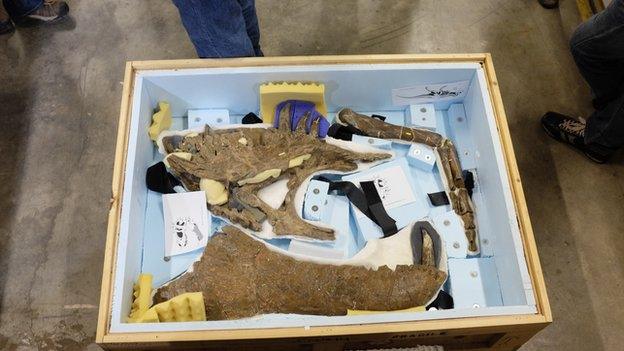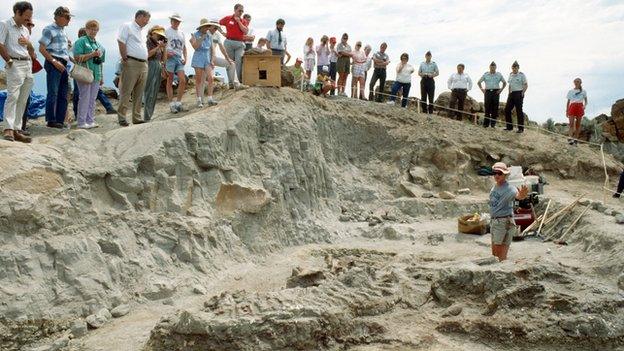How to move a T-Rex dinosaur across the US
- Published
One of the most complete tyrannosaurus skeletons ever found is being moved from Montana to Washington DC. There, hundreds of millions of people will eventually be able to view it.
Inside a museum basement in Montana, a small team of scientists have been preparing a dinosaur for an extraordinary road trip.
Bones the size of a child and others that are mere fragments have been examined, photographed, checked off lists, placed in cushioning cradles and packed in 16 wooded crates.
These are the 66 million-year-old remains of the Wankel T-Rex, one of the most complete tyrannosaurus skeletons ever discovered and now bound for the Smithsonian's National Museum of Natural History in Washington.
"The work has been intense because of the scrutiny this fossil is under from the media and the public," says Cathy Van Arsdale, a physical anthropologist with the Army Corps of Engineers, which owns the bones because they were found on government land.
For a quarter of a century, the Wankel T-Rex has been a fixture at the Museum of the Rockies in Bozeman, Montana. But the Army Corps of Engineers has now agreed a 50-year loan to the Smithsonian, where it will form the centrepiece of the Natural History Museum's new dinosaur hall, due to open in 2019.
"It's a pretty big deal for me personally," says Matthew Carrano, the museum's curator of dinosauria. "Maybe once in your lifetime you get to receive a nearly complete T-Rex and this is that moment for me."
The Wankel is named after Kathy Wankel, a Montana rancher who discovered the bones in 1988 in an area known as the Hell Creek Formation. The remains included the first complete forearm - a tiny limb in comparison to the rest of the body.

The T-Rex's forearm can be seen at the top-right of this packing box
As a result, it's one of the most studied T-Rex skeletons in the world, but Carrano says it may yet reveal new information - such as what the arm with its pincer-like thumb and forefinger was used for.
"Once you have a dinosaur right in front of you, you don't know what ideas you're going to get. So once it comes to the Smithsonian I think we'll start to generate new hypotheses."
Dinosaur bones have been shipped all over the world from Montana ever since the mid-1800s. The geology and lack of vegetation in parts of the western US mean that fossils are never far from the surface, which is why so many are found there.
"If you were to go east, to Washington DC for example, there are dinosaur fossils there," says Carrano. "But they're under the grass, the trees and the buildings, so it's pretty rare we get a chance to look at the rocks, much less find dinosaurs in them."
The Wankel is the first real T-Rex to be held by the Smithsonian. The skeleton currently on display is a life size replica of Stan, whose actual remains are housed by a private research company in South Dakota. In 1997 the Smithsonian tried to acquire Sue, a much bigger and more complete tyrannosaurus, but was out-bid at auction by Chicago's Field Museum of Natural History.
Only around 50 sets of T-Rex remains have been unearthed so far, and only about half of those are anywhere near complete. The Museum of the Rockies owns 12 and will replace the Wankel with another specimen. It also has a life-size bronze replica called Big Mike, which greets visitors at the entrance to the museum.
"We've had [the Wankel] on exhibit in its death pose - basically in the position we found it - and a lot of people got to see it the way it was," says Pat Leiggi, director of exhibits at the Museum of the Rockies.
"But we've spent more than two decades with this skeleton and people here are very proud to see it go to a national museum."
Leiggi was part of the team that took two years to excavate the Wankel. He still remembers the excitement when Kathy Wankel brought a box of the first bones into the museum for scientists to look at.
"It was beautiful. It was the first complete arm from a T-Rex," he says. "We went back [to the site] in the spring and saw some more bones sticking out. In the fall we uncovered the body vertebrae and located the skull.
"How many people get to see a T-Rex in the ground? Not that many. The idea you get to work on a T-Rex is pretty fabulous."
An enormous climate-controlled truck under constant satellite surveillance is transporting the Wankel from Bozeman to Washington - a 2,300-mile (3,700km) non-stop journey that will take 48 hours. But its journey won't end there.

The Wankel T-Rex was excavated in Montana a quarter of a century ago
The bones will be individually on display at the Natural History Museum for a few months while scientists assess their condition and scan them to create a digital model. They'll then be sent to a facility near Toronto, Canada, where the armature and pose will be created. Once that's constructed it will be dismantled, brought back to Washington and re-assembled.
Meanwhile, the existing dinosaur hall will close at the end of the month for a $70m (£42m) renovation. When it re-opens in 2019, the Smithsonian estimates that an estimated 400 million people will see Wankel over the next 50 years, make it arguably the most visible T-Rex in the world.
But it won't be called the Wankel. The pride of the Natural History Museum will have a new name - the Nation's T-Rex.
Follow @BBCNewsMagazine, external on Twitter and on Facebook, external